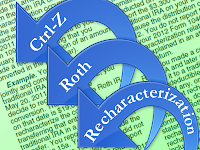 Even though the 2011 tax season for most of us ended on April 17, 2012, some of us who made a timely IRA contribution for 2011 might have changed our mind on that IRA contribution. Specifically, some individuals who contributed to one type of IRA for last year may now want to change that contribution into a different type of IRA contribution.
Even though the 2011 tax season for most of us ended on April 17, 2012, some of us who made a timely IRA contribution for 2011 might have changed our mind on that IRA contribution. Specifically, some individuals who contributed to one type of IRA for last year may now want to change that contribution into a different type of IRA contribution.
A “recharacterization” allows individuals, after-the-fact, to change their IRA contribution into a different type of IRA contribution if certain rules are met. The 2011 IRA contribution deadline was April 17, 2012, so anyone who didn’t make a contribution by that time cannot do so now. However, those who did can change their mind by recharacterizing.
To recharacterize a 2011 contribution, you must have the original contribution (plus interest) transferred directly to the second IRA of a different type (e.g., Traditional IRA to Roth IRA). If this is done by October 15, 2012, you treat the 2011 IRA contribution as having been originally made to the second IRA.
The most common recharacterization occurs after someone converts funds from a Traditional IRA to a Roth IRA. Afterwards, that individual may want to undo the conversion, usually because they don’t have the money to pay the taxes on the conversion or because the investments in the Roth IRA declined significantly. That person could simply recharacterize the Roth conversion plus its net income (or loss) back to a Traditional IRA. The tax debt on the conversion is erased as if the funds were never converted to a Roth IRA.
Recharacterizations are not taxable but they must be reported to the IRS, so anyone who filed their 2011 tax return by April 17, 2012 and then properly recharacterizes a 2011 contribution or conversion by October 15, 2012 would have to file an amended tax return to report the recharacterization. Even if you do the recharacterization before you file your return, you must report the recharacterization on your return so that IRS can properly match up the tax reporting for all transactions. We have seen a number of individuals who missed this step and got letters from IRS looking for taxes that were no longer owed due to a recharacterization. The instructions for reporting a recharacterization can be found in the instructions for IRS Form 8606.
IRS Publication 590, Individual Retirement Arrangements is a good source of information on recharacterizations. Both the IRS Publication 590 and Form 8606 are available on the IRS website www.irs.gov.
-By Joe Cicchinelli and Jared Trexler









0 comments:
Post a Comment